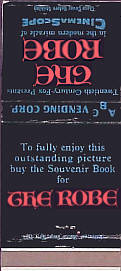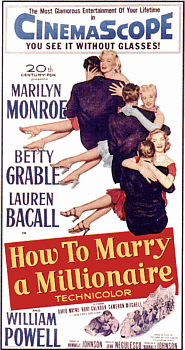BANNER ACROSS BOTTOM OF FRONT PAGE OF
SEPTEMBER 24, 1953 HOLLYWOOD REPORTER
The boys at the Sands casino tempt readers to do what Fox had done with CinemaScope - take a BIG gamble. Fox, it turns out, beat the odds substantially. The Robe opened in Los Angeles a week after it had premiered in New York and Chicago. The Roxy in New York recorded a world's record gross in the first week.

 In The Modern Miracle of CinemaScope
In The Modern Miracle of CinemaScope
Close Cover Before Striking
Above left, a matchbook cover promotes the sale of the program book for The Robe. Above right, the program book in question. Not shown to scale.


How to Marry a Millionaire released on the coat tails of The Robe, it was begun after the latter and completed before it.
Fox had been developing The Robe for several years and they were intent that it would showcase CinemaScope's introduction. For pure entertainment, those three girls were probably a better bet, but The Robe had action sequences that overcame the static photography from which a number of the early productions suffered.
Also in production at the same time as The Robe and How to Marry a Millionaire was Beneath the 12-Mile Reef, all of which used original Chrétien lenses, (the only three deemed to be of adequate quality to be used). Had the film been produced in standard black and white it would probably have qualified as an above average "B" picture. With the beautiful Technicolor (Eastmancolor negative) CinemaScope photography, stereophonic sound, and an especially evocative music score by Bernard Herrmann, Beneath the 12-Mile Reef becomes an entertainment worthy of pulling audiences away from their televisions. Young Robert Wagner and gorgeous Terry Moore play the romantic leads and Gilbert Roland plays the same part that he played in dozens of films.
SEX IN THE CINEMA
Ooh! Mr. Zanuck's is bigger!
Fox used its most powerful sales people to promote CinemaScope. Cinerama didn't have Monroe, Paramount didn't have Monroe, Fox had Monroe and she was in CinemaScope. Did she contribute to the success of Fox's wide screen system over the competition? Most likely, the answer is yes. At right, Marilyn is seen fondling a Bausch & Lomb Type I CinemaScope projection lens, which sold for over $2,800 per pair at a time when American G.I.s were returning from Korea and buying their first homes for $5,000. Hold on to that lens a little tighter, Marilyn!
The Dynamo images courtesy of Steve Stuart

More Goodies on How To Marry A Millionaire - Click the poster

One of the earliest, and best, examples of CinemaScope, Walt Disney's 20,000 Leagues Under The Sea (1954). This illustration shows the four magnetic soundtracks. With the addition of sound on the picture film, CinemaScope's original 2.66:1 aspect ratio was reduced to 2.55:1.
The squarer "FoxHole" sprocket holes were used to allow for slightly wider magnetic stripes than the conventional Kodak or Bell & Howell sprocket holes would allow. The narrow track carried the effects channel sound. Control tones turned the auditorium amplifiers on and off as required because the narrow track tended to be "hissy" when no sound was present.
Disney's first foray into live CinemaScope feature production is as worthy of his legacy as anything else he produced. 20,000 Leagues Under the Sea continues to captivate old timers that saw it as children and their own children and grand children. What a disappointment to read Verne's novel after seeing this masterpiece created by Disney with the considerable talents of director Richard Fleischer and writer Earl Felton, a team that created some of the best "B" and films noir at RKO in the late forties and early fifties. And Harper Goff's designs for the ship and diving suits are pure classic that are vastly more interesting than those described in Verne's novel.
©1954 WDP
The squeezed image on film is projected through an anamorphic lens to expand the picture to its correct dimensions, just a bit less wide than the silly CinemaScope promo pictured on the previous page. The anamorphic camera adapters were in such short supply when this and all the other early CinemaScope films were made that each production was allocated a single lens. If a second lens was absolutely necessary it would be dispatched by motorcycle courier from the 20th Century Fox camera department.

Not in CinemaScope but it still brings back great memories for your curator. Another Dell Movie Classic.
| 
The circle in front of the camera is the Bausch & Lomb CinemaScope adapter lens getting its own picture taken during the filming of 20,000 Leagues Under The Sea.
|
Harper Goff's remarkable design of the Nautilus and divers' suits remain a landmark in film history. One merely has to look at the two "remakes" that appeared on television in recent years to see how Goff, even more than Verne, hit upon a look that sticks in memory and seems to convey, simultaneously, a Victorian and futuristic look that makes the story work so well. CinemaScope may not have been a critical part of the production but it forever makes it a contemporary film with quality wide screen camera work and marvelous four track stereophonic sound. No amount of CGI could have improved what the Disney team pulled off in 1954.
 Royalty merited CinemaScope treatment as we see in the official documentation of Her Majesty Elizabeth II and Prince Philip's tour of the British Empire. A few years later, Princess Grace and Prince Rainier of Monaco would be married in front of the CinemaScope cameras.
Royalty merited CinemaScope treatment as we see in the official documentation of Her Majesty Elizabeth II and Prince Philip's tour of the British Empire. A few years later, Princess Grace and Prince Rainier of Monaco would be married in front of the CinemaScope cameras.

Fox, unlike M-G-M, Warner Bros., Paramount, and Universal, was the only major studio that didn't have its own cartoon division. For whatever reason, they distributed the cheesy Terrytoons productions that were made in CinemaScope. Better to have had no cartoons at all. The quality of the artwork in this trade journal ad pretty well says it all for Terrytoons. Don't you just know that those things really packed them in?

Columbia Pictures had a bit more lucrative property in their releases of UPA's Mr. MaGoo, a wildly popular character throughout the 1950s, though he seldom got CinemaScoped. Sadly, all animated films took on a cheesy look in the 1950s due to budget restraints. Even Disney animation quality suffered substantially.

The CinemaScope Film That Should Not Have Been Made.
While RKO adopted the Tushinsky Superscope system for their resident wide screen process, they did produce at least two films in CinemaScope. This one has an unusual and regrettable legacy. It should not have been made for countless reasons, specifically, John Wayne was not talented enough to pass himself off as a Mongol, the story line was dopey, and worst of all it is quite likely that this film cost many of the cast and crew their lives. Filmed in the Nevada desert in 1956 near a site where atmospheric nuclear weapons testing was being conducted, the film holds the record for the number of people that ultimately died of cancer, including: John Wayne, Susan Hayward, Dick Powell, Pedro Armendarez, Agnes Moorehead, and probably others that are not so well known. Studio owner Howard Hughes died many years later, but his death was caused by terminal weirdness.
You are on Page 3 of 








©1996 - 2013 The American WideScreen Museum
http://www.widescreenmuseum.com
Martin Hart, Curator


